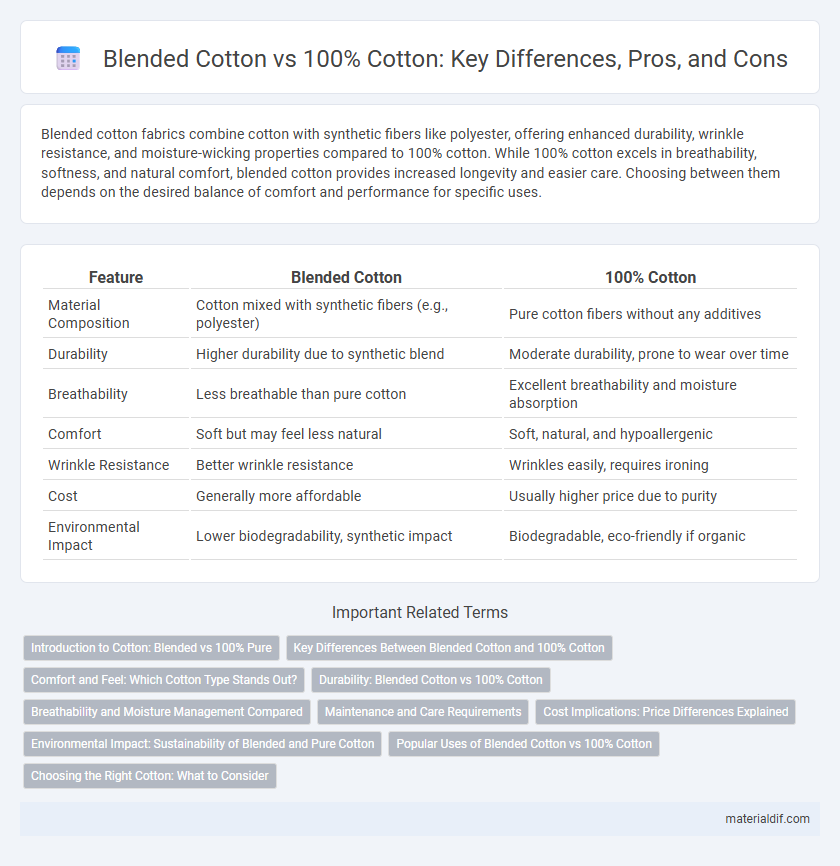Blended cotton fabrics combine cotton with synthetic fibers like polyester, offering enhanced durability, wrinkle resistance, and moisture-wicking properties compared to 100% cotton. While 100% cotton excels in breathability, softness, and natural comfort, blended cotton provides increased longevity and easier care. Choosing between them depends on the desired balance of comfort and performance for specific uses.
Table of Comparison
| Feature | Blended Cotton | 100% Cotton |
|---|---|---|
| Material Composition | Cotton mixed with synthetic fibers (e.g., polyester) | Pure cotton fibers without any additives |
| Durability | Higher durability due to synthetic blend | Moderate durability, prone to wear over time |
| Breathability | Less breathable than pure cotton | Excellent breathability and moisture absorption |
| Comfort | Soft but may feel less natural | Soft, natural, and hypoallergenic |
| Wrinkle Resistance | Better wrinkle resistance | Wrinkles easily, requires ironing |
| Cost | Generally more affordable | Usually higher price due to purity |
| Environmental Impact | Lower biodegradability, synthetic impact | Biodegradable, eco-friendly if organic |
Introduction to Cotton: Blended vs 100% Pure
Blended cotton fabrics combine natural cotton fibers with synthetic materials such as polyester to enhance durability, wrinkle resistance, and cost-effectiveness. In contrast, 100% cotton offers superior breathability, softness, and hypoallergenic properties, making it ideal for sensitive skin and high comfort. Understanding the differences in fiber composition helps consumers choose between performance benefits and natural fabric qualities.
Key Differences Between Blended Cotton and 100% Cotton
Blended cotton fabrics combine cotton with synthetic fibers like polyester, enhancing durability, wrinkle resistance, and color retention compared to 100% cotton, which offers superior breathability, softness, and natural hypoallergenic properties. The moisture-wicking ability of 100% cotton makes it ideal for sensitive skin and warmer climates, while blended cotton fabrics are often preferred for their lower cost and reduced shrinkage after washing. Understanding these differences helps consumers select the best fabric based on comfort, maintenance, and use-case scenarios.
Comfort and Feel: Which Cotton Type Stands Out?
Blended cotton fabrics combine natural cotton fibers with synthetic materials like polyester, enhancing durability and wrinkle resistance while maintaining a soft feel. In contrast, 100% cotton offers superior breathability and a natural, breathable comfort that feels gentle against the skin, ideal for sensitive or allergy-prone individuals. When prioritizing comfort, 100% cotton stands out for its softness and moisture-wicking properties, although blended cotton can provide a more durable and wrinkle-free fabric experience.
Durability: Blended Cotton vs 100% Cotton
Blended cotton fabrics, often mixed with synthetic fibers like polyester, enhance durability by resisting wear and tear better than 100% cotton, which tends to weaken and pill over time. The synthetic components in blended cotton increase tensile strength and reduce shrinkage, making blended fabrics more resilient in frequent washing and heavy use. While 100% cotton offers breathability and softness, its durability is comparatively lower due to natural fiber breakdown and susceptibility to fading.
Breathability and Moisture Management Compared
Blended cotton fabrics often combine natural cotton fibers with synthetic materials like polyester, enhancing durability and wrinkle resistance without significantly compromising breathability. In contrast, 100% cotton fabrics excel in moisture absorption and breathability, allowing better air circulation and natural moisture wicking, which makes them ideal for hot and humid climates. While blended cotton may offer improved moisture management through synthetic fibers that dry faster, 100% cotton remains superior in providing a soft, breathable, and comfortable experience.
Maintenance and Care Requirements
Blended cotton fabrics, combining cotton with synthetic fibers like polyester, require less maintenance due to increased wrinkle resistance and quicker drying times compared to 100% cotton, which demands more frequent ironing and careful washing to prevent shrinkage. 100% cotton is more breathable and naturally soft but tends to fade and wear out faster without proper care, often needing gentle cycles and low-temperature drying. Blended cotton offers durability and ease of care, making it ideal for everyday wear, while 100% cotton suits those prioritizing natural fiber comfort despite higher maintenance efforts.
Cost Implications: Price Differences Explained
Blended cotton fabrics typically cost less than 100% cotton due to the inclusion of synthetic fibers, which reduce production expenses and enhance durability. The lower price of blended cotton makes it a popular choice for budget-conscious consumers seeking affordability without sacrificing too much quality. In contrast, 100% cotton commands a higher price because of its natural fibers, superior breathability, and hypoallergenic properties, justifying the premium cost for those prioritizing comfort and natural materials.
Environmental Impact: Sustainability of Blended and Pure Cotton
Blended cotton fabrics combine cotton with synthetic fibers, often reducing water and pesticide use compared to conventional 100% cotton, but complicate recycling processes due to fiber separation challenges. In contrast, 100% cotton, especially organic varieties, offers greater biodegradability and lower microplastic pollution, promoting a more sustainable lifecycle. However, pure cotton cultivation can demand substantial water and chemical inputs, influencing its overall environmental footprint.
Popular Uses of Blended Cotton vs 100% Cotton
Blended cotton combines natural cotton fibers with synthetic materials like polyester, enhancing durability and wrinkle resistance, making it ideal for activewear, casual clothing, and affordable home textiles. In contrast, 100% cotton is preferred for premium bedding, high-quality casual wear, and sensitive skin products due to its breathability, softness, and hypoallergenic properties. The choice between blended and 100% cotton depends on desired texture, durability, and comfort priorities in various apparel and textile applications.
Choosing the Right Cotton: What to Consider
When choosing between blended cotton and 100% cotton, consider factors like breathability, durability, and maintenance. 100% cotton offers superior softness and moisture absorption, making it ideal for sensitive skin and warm climates, while blended cotton often includes synthetic fibers that enhance wrinkle resistance and elasticity. Evaluate your lifestyle needs, fabric performance, and washing preferences to select the right cotton type for comfort and practicality.
Blended Cotton vs 100% Cotton Infographic

 materialdif.com
materialdif.com